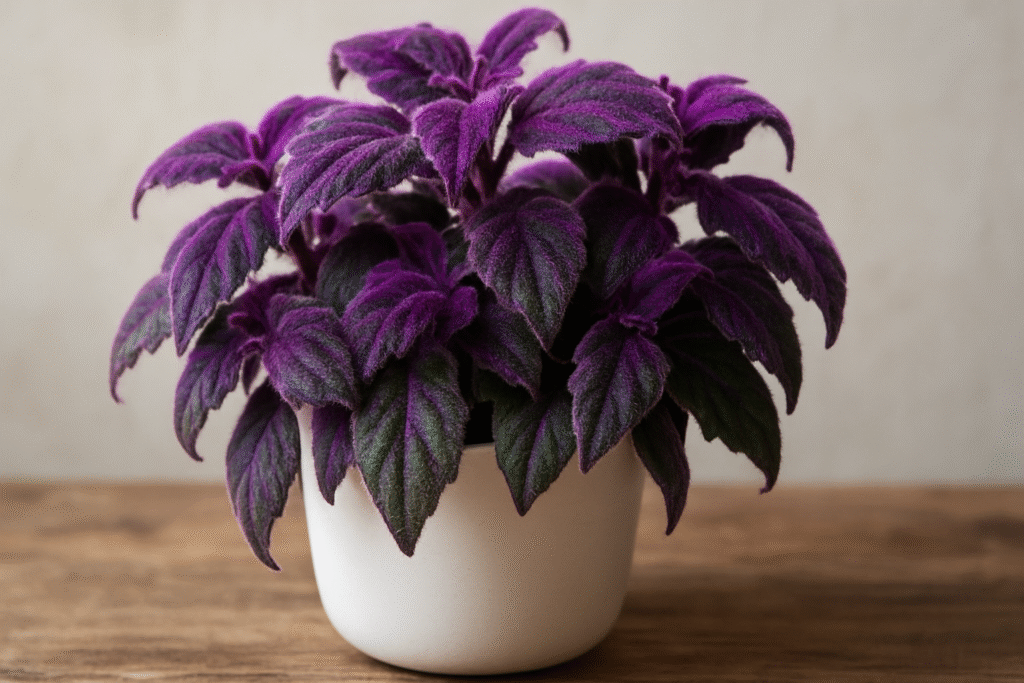The Purple Passion Plant, scientifically known as Gynura aurantiaca, is one of the most striking and unique houseplants you can add to your indoor collection. Its deep green leaves covered in vibrant purple hairs give it a velvety texture and a glowing appearance under light. Often called the “Velvet Plant,” it’s prized for its unusual color and fuzzy surface that sets it apart from other houseplants.
Native to the tropical regions of Southeast Asia, the Purple Passion Plant grows naturally in humid, warm environments. It’s a fast-growing vine that can quickly fill hanging baskets or pots with lush purple foliage, bringing a touch of exotic elegance to your home or garden.
This article explores everything you need to know about this fascinating plant — from its origins and appearance to care, propagation, and troubleshooting tips — so you can help your Purple Passion thrive for years.
Origin and Background
The Purple Passion Plant belongs to the Asteraceae family, which also includes daisies and sunflowers. In its native habitats across Indonesia and Java, the plant grows as a sprawling vine under the filtered light of tropical forests.
In the early 20th century, it became popular in Europe and America as an ornamental indoor plant due to its unusual velvet texture and luminous purple color. Today, it’s still a favorite for houseplant lovers looking for something bold and different.
Appearance and Characteristics
The standout feature of the Purple Passion Plant is undoubtedly its purple hairs that cover the green leaves and stems. These fine hairs give the foliage a soft, velvety texture and an iridescent glow when light hits them at the right angle.
The leaves themselves are ovate with slightly serrated edges, and the undersides often have a darker, richer purple tone. The plant tends to grow as a low, spreading vine when young but can climb or trail as it matures.
When well cared for, the Purple Passion can reach up to 12 to 24 inches tall and spread several feet in width, depending on how it’s trained or pruned.
During maturity, the plant produces small orange or yellow flowers. While these blooms are bright and interesting, many growers pinch them off early because they can emit a strong odor.

Light Requirements
The Purple Passion Plant thrives in bright, indirect light. Direct sunlight can scorch its delicate leaves, fading the vibrant purple hue, while too little light causes the plant to lose its rich color and become leggy.
A location near an east-facing or north-facing window is ideal, where the plant can receive gentle, filtered light throughout the day. If you notice the purple color fading, it’s a sign the plant needs more light.
If growing indoors, artificial grow lights can also supplement natural light, especially during winter months or in low-light rooms.
Temperature and Humidity
Because it originates from tropical regions, the Purple Passion Plant prefers warm temperatures between 18°C and 26°C (65°F–80°F). It doesn’t tolerate cold drafts or sudden temperature changes well, so avoid placing it near air conditioners or open windows during chilly weather.
Humidity plays an important role in its growth. The plant loves a humid environment — around 50–60% humidity is ideal. If your home is dry, consider misting the leaves occasionally, placing the pot on a pebble tray filled with water, or using a humidifier nearby.
Avoid misting excessively, as too much moisture on the leaves can lead to fungal growth or rot.
Watering Needs
The Purple Passion Plant prefers consistently moist soil, but it should never be soggy. Overwatering is one of the most common mistakes with this plant.
A good rule of thumb is to water when the top inch of soil feels dry to the touch. During the active growing season (spring and summer), it may need watering two to three times per week, depending on indoor humidity and light.
In fall and winter, reduce watering frequency as the plant’s growth slows. Always ensure proper drainage — a pot with holes at the bottom is essential to prevent root rot.
If the leaves start drooping, it’s a sign the plant is thirsty, but if they appear mushy or discolored, it’s likely overwatered.
Soil Requirements
The Purple Passion Plant thrives in well-draining, slightly acidic soil. A mix of standard potting soil combined with perlite or coarse sand works well. This combination ensures aeration and prevents waterlogging.
An ideal mix could be:
- 2 parts peat moss or coco coir
- 1 part perlite
- 1 part garden soil or compost
Adding a bit of organic matter helps provide nutrients for vibrant growth and healthy leaves.
Fertilization
Feed the Purple Passion Plant every two to four weeks during the growing season with a balanced, water-soluble fertilizer diluted to half strength. Fertilizing encourages stronger stems and brighter leaf color.
During autumn and winter, stop fertilizing — the plant’s natural growth slows, and feeding can lead to a buildup of salts in the soil.
Always water before fertilizing to avoid root burn.

Pruning and Maintenance
The Purple Passion Plant grows quickly, and without proper pruning, it can become leggy and uneven. Regular pruning helps maintain a fuller, bushier shape and stimulates new growth.
Pinch off the tips of stems when they grow too long, especially during spring and summer. This encourages branching and denser foliage.
You can also remove older or yellowing leaves to keep the plant tidy.
If the plant begins to look sparse or woody at the base, take cuttings and start new plants — it’s a great way to rejuvenate your collection.
Propagation
Propagation of the Purple Passion Plant is very easy, making it ideal for beginners. The most common and successful method is stem cuttings.
Here’s how to propagate it:
- Take a healthy stem cutting about 4–6 inches long just below a leaf node.
- Remove the lower leaves, leaving two or three at the top.
- Place the cutting in a glass of water or directly in moist potting mix.
- Keep it in a warm spot with indirect light.
- Roots should form within 7–10 days.
Once the roots are about an inch long, you can transplant the cutting into a small pot. This method ensures a new plant that’s genetically identical to the parent.
Repotting
The Purple Passion Plant generally needs repotting every 12 to 18 months, or when roots start growing out of the drainage holes. Choose a pot one size larger than the current one to give roots room to grow.
Repotting not only refreshes the soil but also prevents root crowding. Always handle the plant gently, as the fuzzy leaves are delicate and can bruise easily.
Common Problems and Solutions
Even though it’s an easy plant, the Purple Passion can face a few issues if its needs aren’t met.
1. Fading Color
If the plant’s purple color fades to green, it’s not getting enough light. Move it to a brighter location with indirect sunlight.
2. Yellowing Leaves
Overwatering is usually the cause. Allow the soil to dry out slightly before the next watering and check drainage.
3. Leggy Growth
This happens when the plant stretches toward light. Prune regularly and place it in brighter conditions.
4. Pests
Common pests like spider mites, aphids, and mealybugs can attack the plant. Wipe the leaves gently with a damp cloth or spray neem oil solution to control infestations.
5. Root Rot
Occurs due to excessive watering or poor drainage. Repot the plant in fresh, well-draining soil and remove any mushy roots.
Flowering
While the Purple Passion Plant does bloom, its flowers are not the main attraction. The orange or yellow blooms have a somewhat unpleasant odor that some find overpowering.
Most growers choose to pinch off the flower buds as soon as they appear to encourage more foliage growth and prevent the plant from diverting energy to blooming.
However, if you enjoy the full life cycle of your plants, allowing it to flower won’t harm it — just ensure the area is well-ventilated.

Lifespan and Renewal
The Purple Passion Plant is known for its fast growth but relatively short lifespan. After about two to three years, the plant may begin to lose vigor and appear woody or sparse.
To maintain a constant supply, it’s best to propagate new plants every year. This keeps your collection fresh, full, and colorful.
Benefits of Growing Purple Passion Plant
- Unique Appearance: Its velvety purple leaves bring a dramatic and luxurious touch to your home decor.
- Air-Purifying Qualities: Like many houseplants, it helps improve air quality by filtering toxins.
- Easy Propagation: You can easily grow multiple plants from one mother plant.
- Compact Growth: Perfect for small spaces, desks, or hanging baskets.
- Great for Beginners: It’s forgiving and adaptable, even if you miss a few care steps.
Decorative and Styling Ideas
The Purple Passion Plant’s rich colors make it a stunning focal point in any indoor space. It looks especially beautiful in hanging baskets, where its trailing stems can cascade naturally.
Pair it with contrasting plants like the Golden Pothos or Spider Plant for a vibrant display. Its velvety purple tones also complement white, cream, or green pots, making it a great addition to modern or bohemian interiors.
If you want a more compact look, pinch back regularly and use decorative planters that highlight the plant’s unique texture.
Seasonal Care Tips
Spring
- Begin fertilizing every two weeks.
- Prune for bushier growth.
- Repot if necessary.
Summer
- Maintain consistent watering and humidity.
- Keep in bright, indirect light.
Fall
- Gradually reduce watering and stop fertilizing.
- Move away from cold drafts.
Winter
- Water sparingly and ensure adequate light indoors.
- Avoid misting excessively.
Conclusion
The Purple Passion Plant is one of nature’s most dazzling creations — a living piece of art that brings texture, color, and vibrancy into any space. Its deep purple hue and soft velvet leaves make it a standout among indoor plants.
With proper light, warmth, and a bit of attention, it rewards you with stunning growth and a truly unique appearance. Though its lifespan may be short, its ease of propagation ensures you’ll never run out of new plants to grow and enjoy.
Whether you’re a seasoned gardener or a beginner, the Purple Passion Plant is a perfect choice to add exotic flair and personality to your plant collection.

